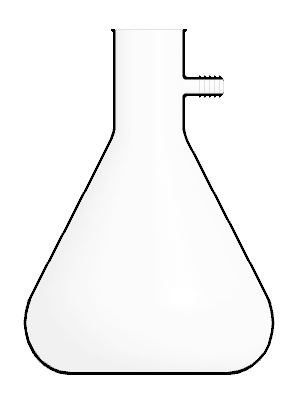Büchner flask facts for kids
A Büchner flask is a special glass bottle used in science labs. It's also known as a vacuum flask, filter flask, side-arm flask, or kitasato flask. It's designed to be very strong.
Contents
What is a Büchner Flask?
A Büchner flask has really thick glass walls. This helps it handle changes in air pressure without breaking. It has an opening at the top where you can fit a Büchner funnel. On the side, there's a small tube with ridges, called barbs. This tube is where you connect a vacuum pump or source. The barbs make sure the vacuum hose stays on tightly.
How to Use a Büchner Flask
Büchner flasks are mostly used for separating solids from liquids. This process is called filtration.
Separating Solids and Liquids
When you want to separate a solid from a liquid, you can use a Büchner flask with a Büchner funnel. Here's how it works:
- You place a special filter paper inside the Büchner funnel.
- You put the funnel into the top opening of the flask.
- You connect a vacuum source to the small side tube of the flask.
- When you pour the mixture of solid and liquid into the funnel, the vacuum pulls the liquid through the filter paper and into the flask.
- The solid parts stay behind on the filter paper in the funnel. This is a much faster way to filter than just letting gravity do the work!
Using it as a Vacuum Trap
Another important use for a Büchner flask is as a "vacuum trap." Imagine you have a vacuum pump that's pulling air from another piece of lab equipment. Sometimes, small amounts of liquid or vapor might accidentally get pulled along with the air. A Büchner flask can be placed in the middle of the vacuum line to catch these liquids. This stops them from reaching and possibly damaging the vacuum pump, or from going into the equipment you are trying to evacuate.
Who Invented the Büchner Flask?
Many people think the Büchner flask was named after Eduard Buchner, who won a Nobel Prize. But actually, it was named after a different person: Ernst Büchner. He was an industrial chemist.
Related Pages
Images for kids
-
A Büchner funnel is attached to the flask via a black elastomer adapter. The hose barb is connected via vacuum hose to a vacuum source such as an aspirator. The flask should be clamped before use or the hose will likely cause it to tip.
See also
 In Spanish: Kitasato para niños
In Spanish: Kitasato para niños




